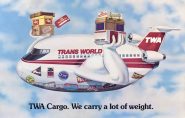
TWA – Trans World Airlines on Postcards
Written by Marvin G. Goldman
TWA served as one of the foremost airlines in the United States, tracing its origin to 1925 when Western Air Express was founded, and operating until acquired by American Airlines in 2001.
TWA itself was formed in 1930 from a combination of Western Air Express and Transcontinental Air Transport (T.A.T.)-Maddux, and was originally known as Transcontinental & Western Air. Briefly, during 1925 to 1930 TWA’s three main predecessors evolved as follows:
— Western Air Express, formed on 13 July 1925, developed a substantial airline network spanning the western U.S. from 1926 to 1930.
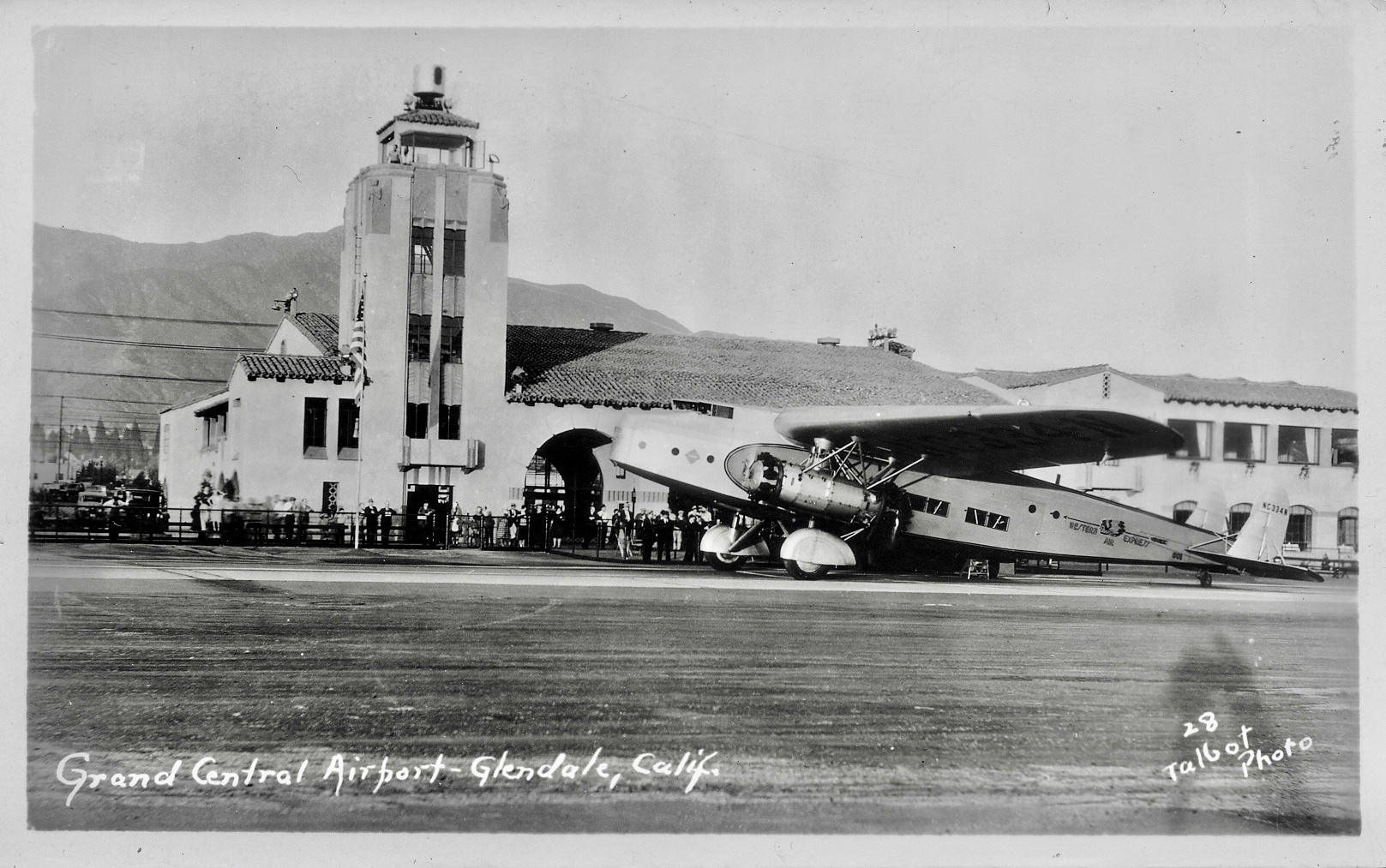
Western Air Express Fokker F-32, NC334N, at Glendale Central Airport, California, 1930. Real photo postcard by Talbot, no. 28. Ex Deke Billings collection. The Fokker F-32 was the largest airliner of its day and the first four-engine transport in the U.S. Western Air Express operated the only two F-32s utilized in passenger service, and the aircraft type had a very short life, only carrying passengers in 1930-31.
— Maddux Air Lines, founded in 1927, developed a significant network in California plus service to Phoenix, Arizona and Agua Caliente, Mexico.
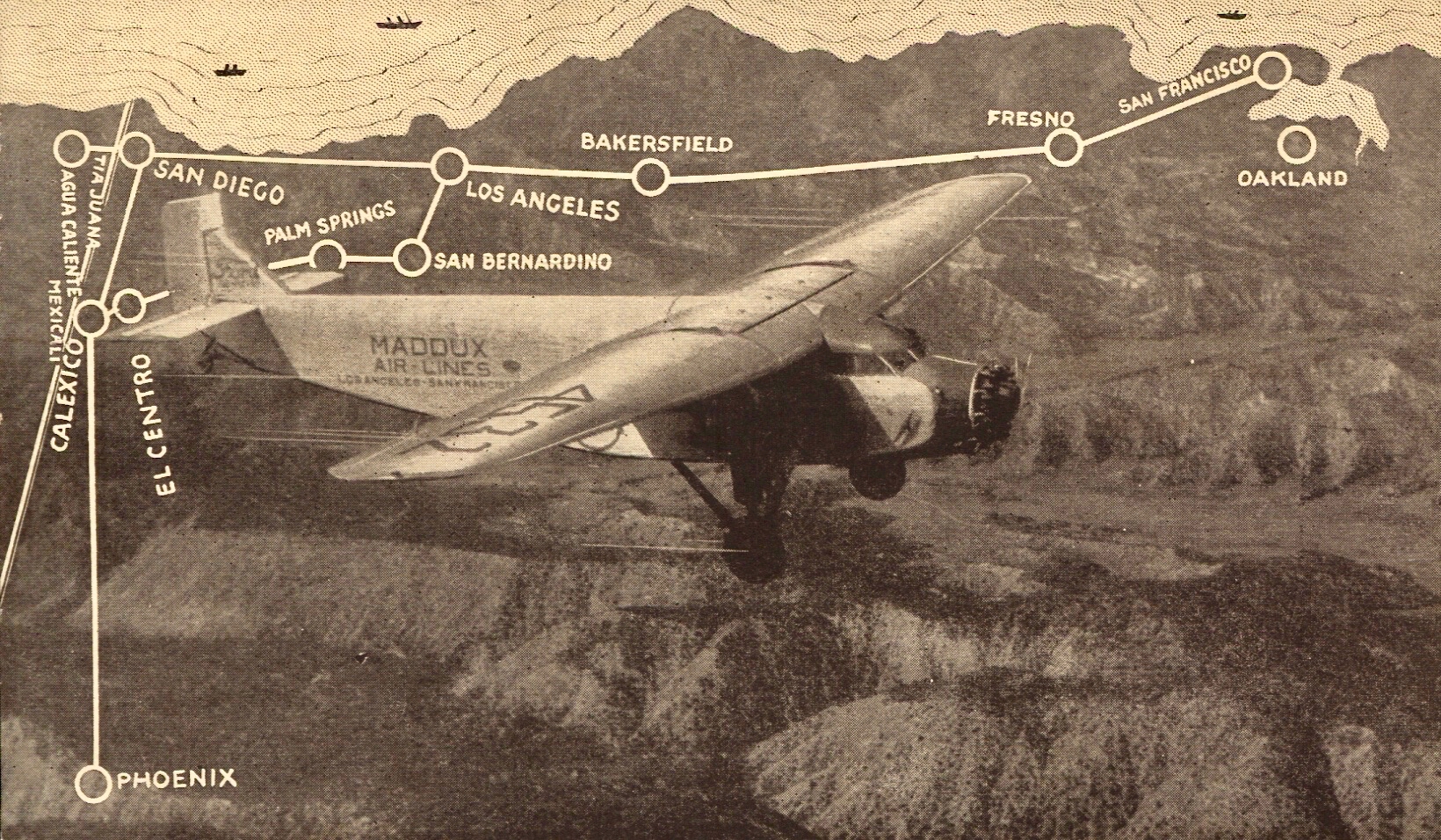
Maddux Air Lines Ford 4-AT Tri-Motor, NC4532, and Route Map. Airline Issue. Ex Deke Billings collection.
— Transcontinental Air Transport (T.A.T.), established in 1929 and backed by railroad interests, started a transcontinental Air-Rail service on 7 July 1929, operating western and eastern portions by air, with passengers transferring to rail service for the central part of the journey.
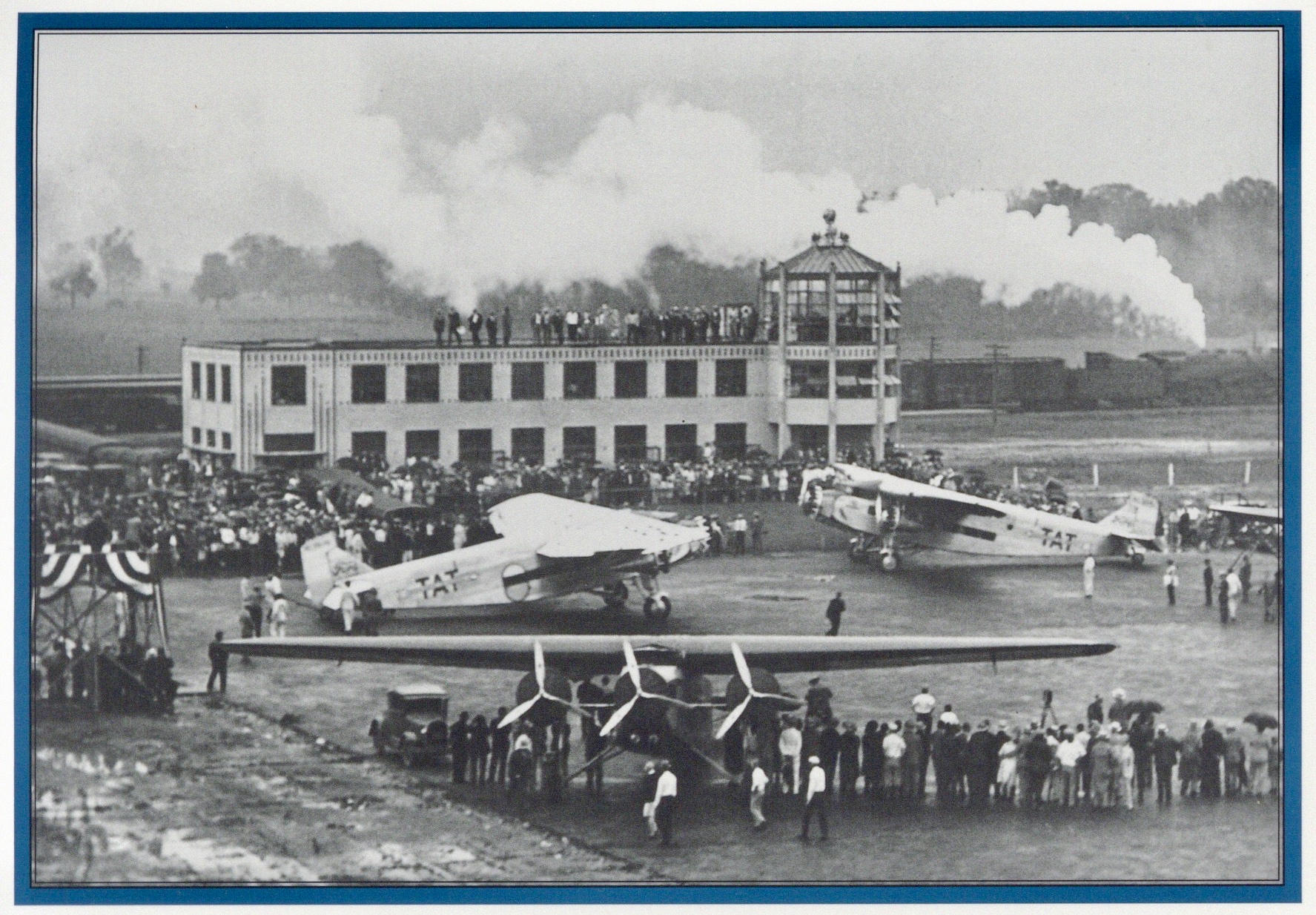
Transcontinental Air Transport (T.A.T.) Ford Tri-Motors at Port Columbus Airport, Ohio, 8 July 1929, at the inauguration ceremony for the eastern link of their Air-Rail transcontinental service. One of a set of postcards issued by Port Columbus Airport for their 75th anniversary in 2004. T.A.T operated a western segment from Glendale, California to Clovis, New Mexico, where passengers would transfer to rail service to Columbus, Ohio, and then resume with T.A.T. aircraft to New York. The Air-Rail arrangement continued into 1930, but thereafter T.A.T.’s aircraft operated the entire transcontinental route.
— T.A.T.-Maddux arose from the merger of Maddux with T.A.T. on 16 November 1929.

T.A.T.-Maddux Curtiss Condor CO at Port Columbus, Ohio, 1930. Pub’r W. E. Ayers Co., Columbus. Printed by Curteich, no. 2268-30. The Curtiss Condor was the last large biplane built in the U.S. T.A.T.-Maddux utilized it to supplement its Ford Tri-Motors.
Under pressure from then Postmaster General Walter Folger Brown, who controlled the awarding of valuable airmail routes and wanted to promote a single transcontinental airline, in a ‘Shotgun Marriage’ the aircraft and other assets of Western Air Express and T.A.T.-Maddux were transferred on 24 July 1930 to a single company, named Transcontinental & Western Air (TWA).
In August 1932, Jack Frye, then Vice President-Operations of TWA, sent a famous letter to Donald Douglas with specifications for a desired new, modern aircraft type. This resulted in a single Douglas Aircraft DC-1 prototype, delivered to TWA on 1 December 1933. The unique DC-1 served as publicity for TWA, and here are two postcards.
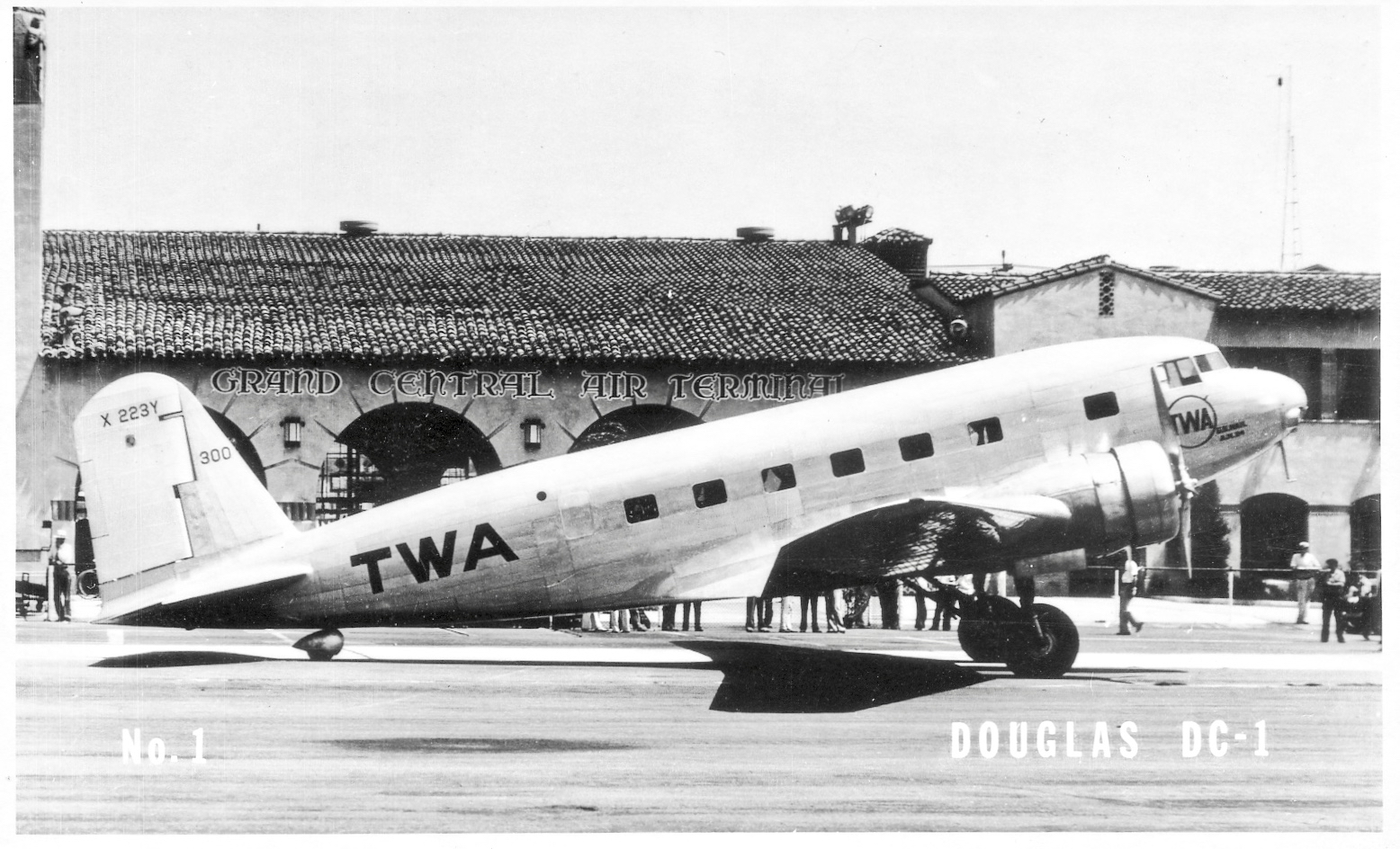
TWA Douglas DC-1 on display at Glendale Central Air Terminal, Glendale, California. Real photo postcard. Ex Allan Van Wickler collection.
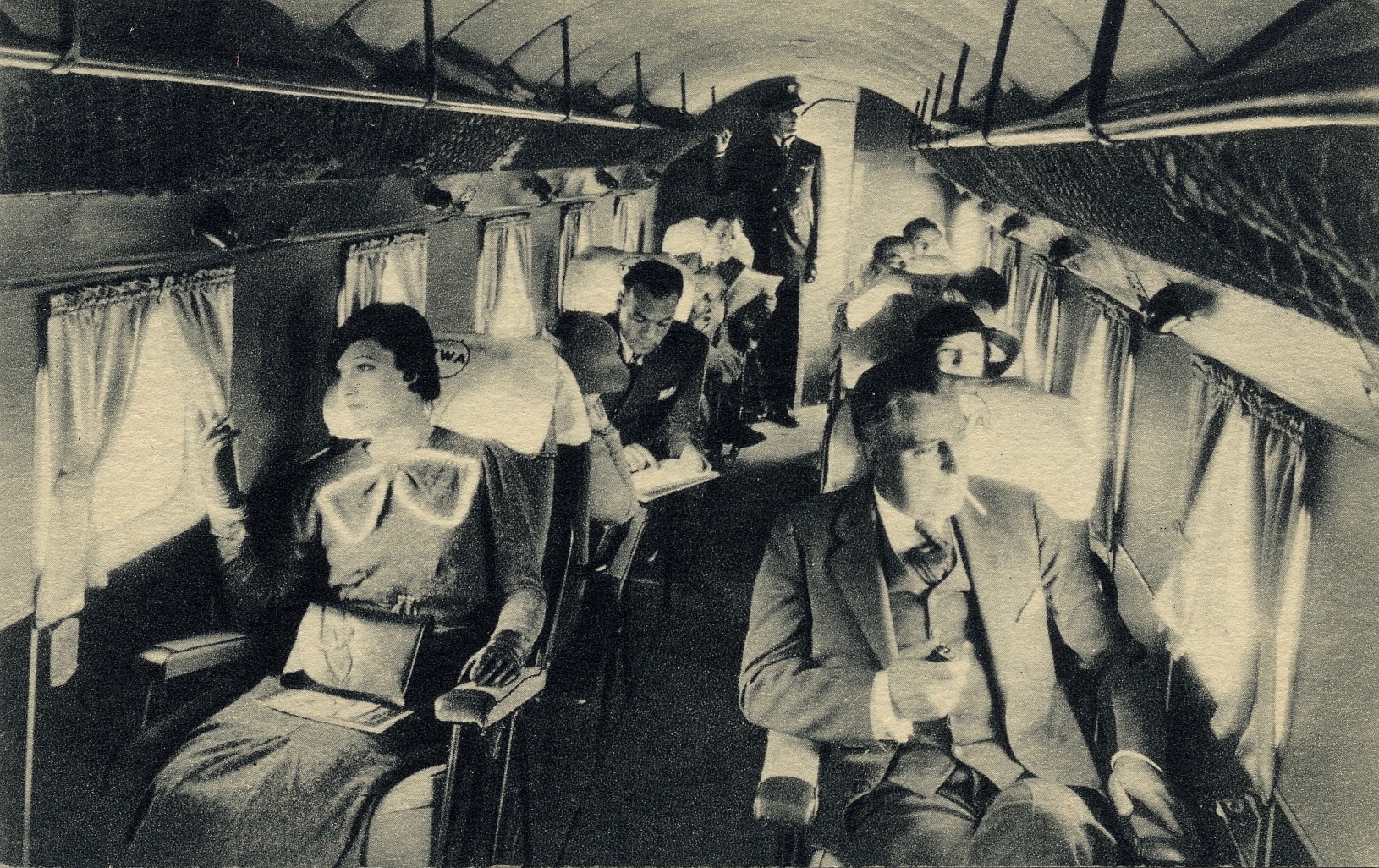
Interior of TWA Douglas DC-1 in a staged scene. Airline Issue. The back of the card states: “QUIET PLEASE! One of the most marvelous achievements contributing to the advancement of air travel is the quiet passenger cabin of the TWA Douglas Luxury Airliner. Conversation may be carried on in normal tone of voice. The cabin is carefully insulated from the engine and propeller noise and vibration. Luxurious deep-cushioned chairs and a wide aisle contribute to absolute comfort.”
Based on the DC-1, Douglas and TWA decided to lengthen the aircraft by two feet, thereby raising the number of seats from 12 to 14. This and other improvements became the DC-2, with the first being delivered to TWA on 18 May 1934, followed by 30 more. The DC-2 represented a tremendous improvement over all other airline types then in operation, and it transformed airline service.
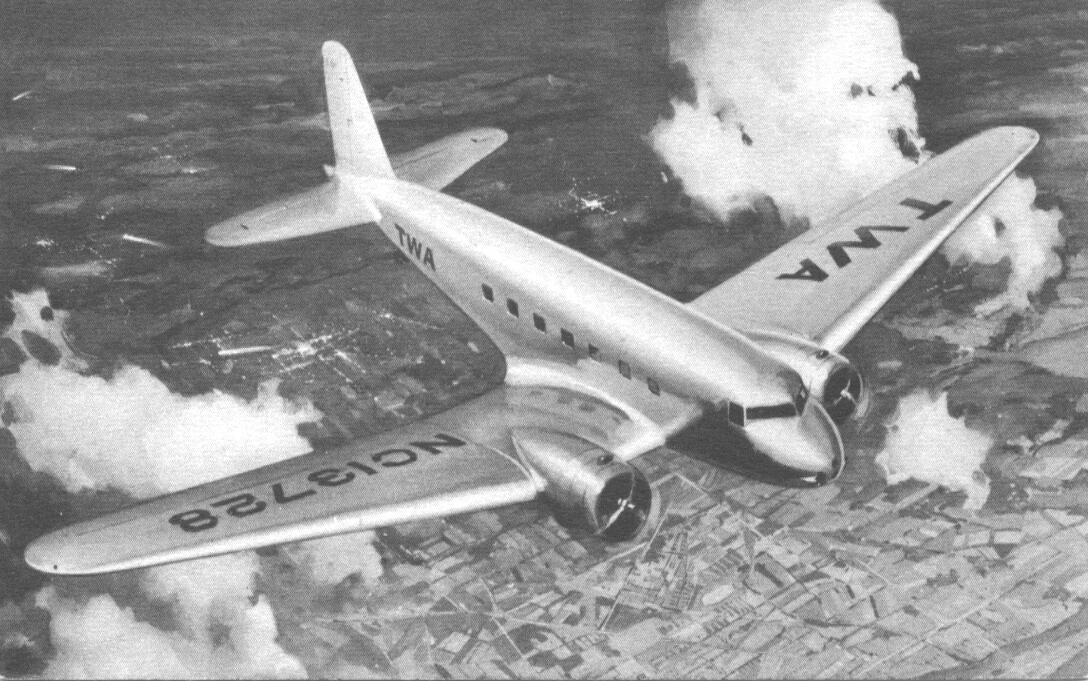
TWA Douglas DC-2, NC13728, delivered to TWA on 21 August 1934. Airline issue. Ex Allan Van Wickler collection.
The DC-2 was followed by the even more advanced Douglas DC-3, including a sleeper version called the DC-3 DST (Douglas Sleeper Transport). The DC-3 exceeded all expectations and became one of the most famous aircraft types in history. TWA introduced DC-3s to its fleet (initially with the DST version) on 1 June 1937, in transcontinental service.
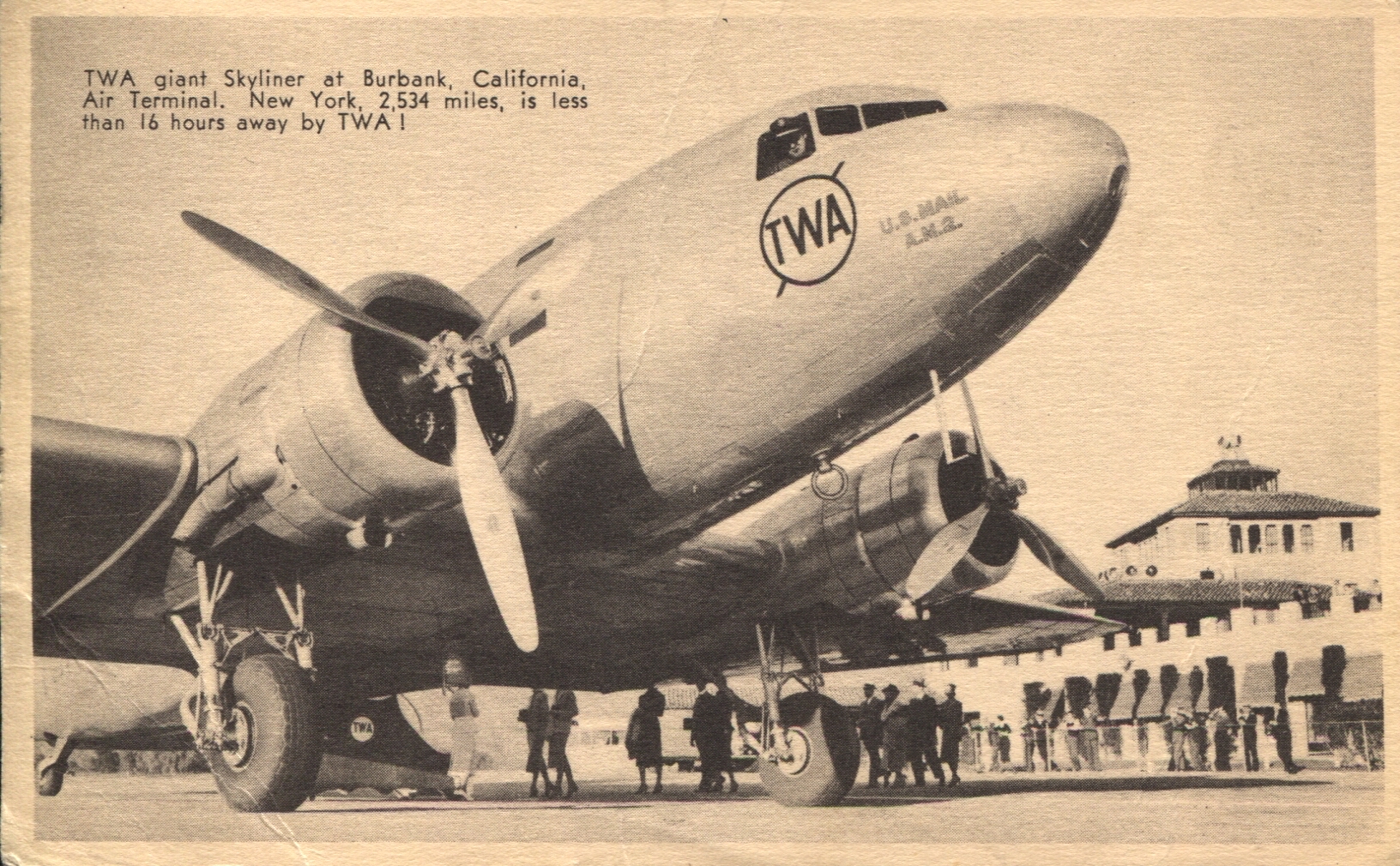
TWA Douglas DC-3 DST at Burbank, California, Airport. Airline issue. My card is postmarked 18 November 1938.

TWA Douglas DC-3 DST, NC17312, at New York. The back of the card states: “TWA’s luxury Skysleepers let you dream your way across the nation. You can leave New York in the evening–and breakfast in Los Angeles the next day, flying the route that’s shortest, fastest, coast-to-coast.”
In May 1940 TWA introduced the four-engine Boeing 307 into service. The Boeing 307 was the first commercial aircraft with a pressurized cabin, allowing it to fly up to 20,000 ft. (6000m), above the often more turbulent weather of lower altitudes. Only 10 examples were delivered — five to TWA and five to Pan American. The aircraft type had a short life due to the intervention of World War II and the post-war development of the Douglas DC-4 and Lockheed Constellation.
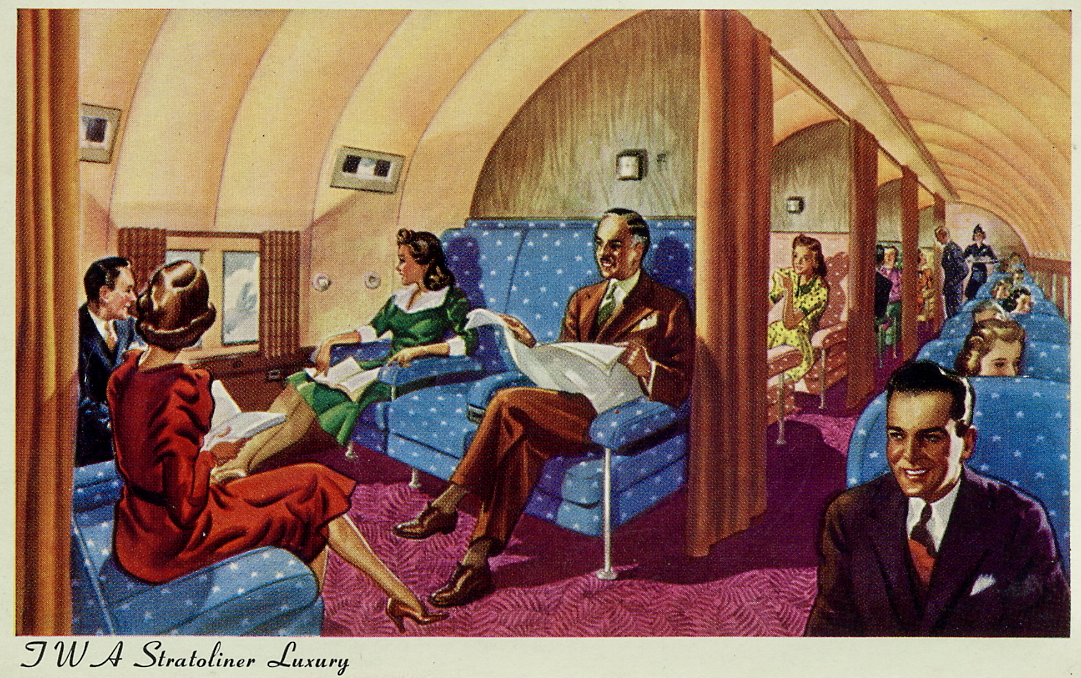
Interior of TWA Boeing 307. Airline issue, probably 1940. The aircraft seated 33 passengers who enjoyed a pressurized cabin for the first time in commercial service.
On 5 July 1945 TWA received authority to operate trans-Atlantic routes for the first time, breaking the monopoly of Pan American. In February 1946 it started adding to its fleet the first two main post-WWII commercial aircraft types — the pressurized Lockheed Constellation, particularly sponsored by TWA, and as backup the unpressurized Douglas DC-4. Each included some models converted from their initial military types.
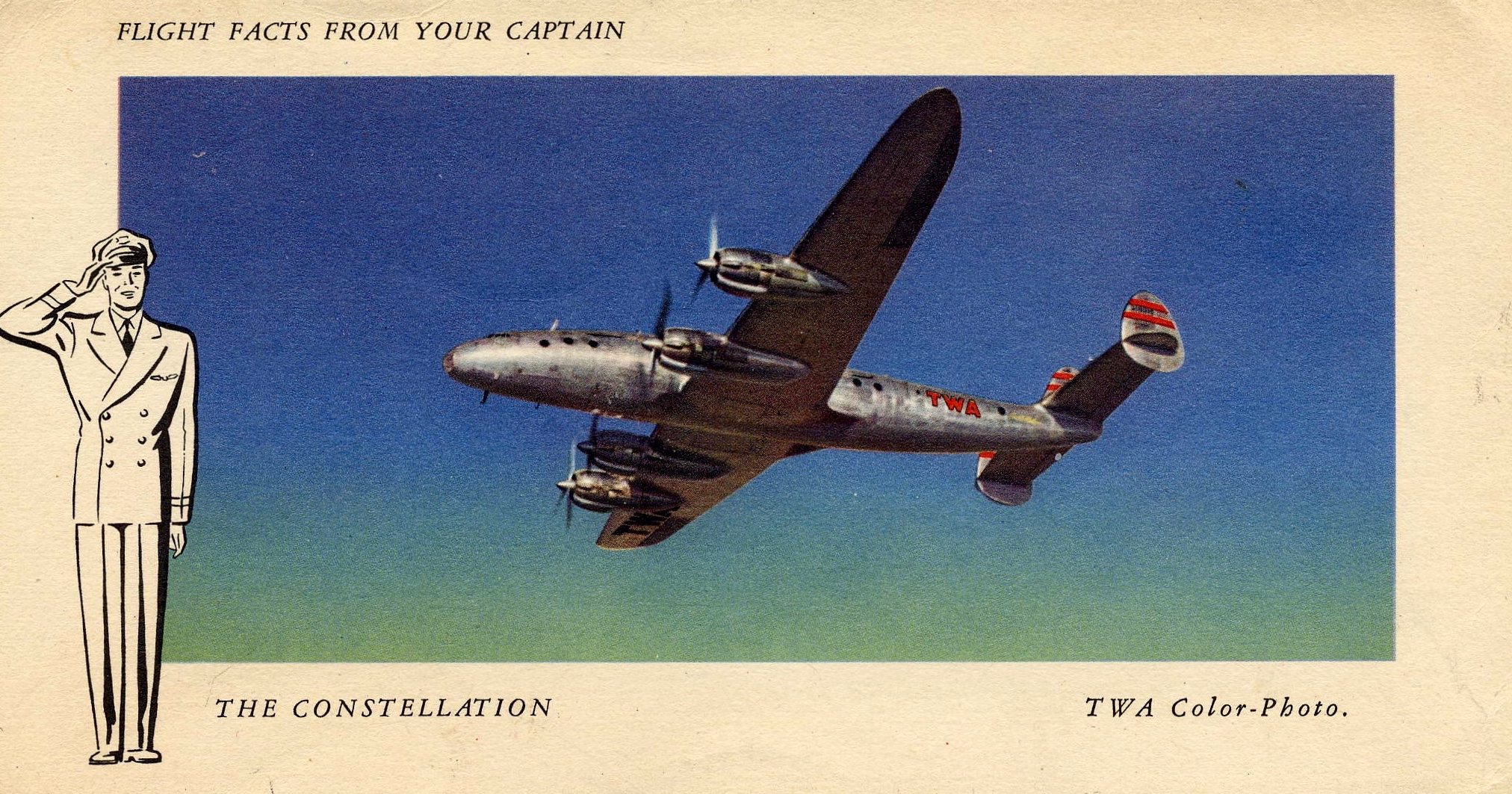
TWA Lockheed 049 Constellation. Airline issue. This is a fold over card with a postcard back. Inside is a Captain’s flight report with details about the specific flight, to be passed around to the passengers. (This is the predecessor of today’s moving maps and information on the screen at each person’s seat). The inside text offers to make a duplicate for mailing if desired. My card’s message is dated 26 September 1946.
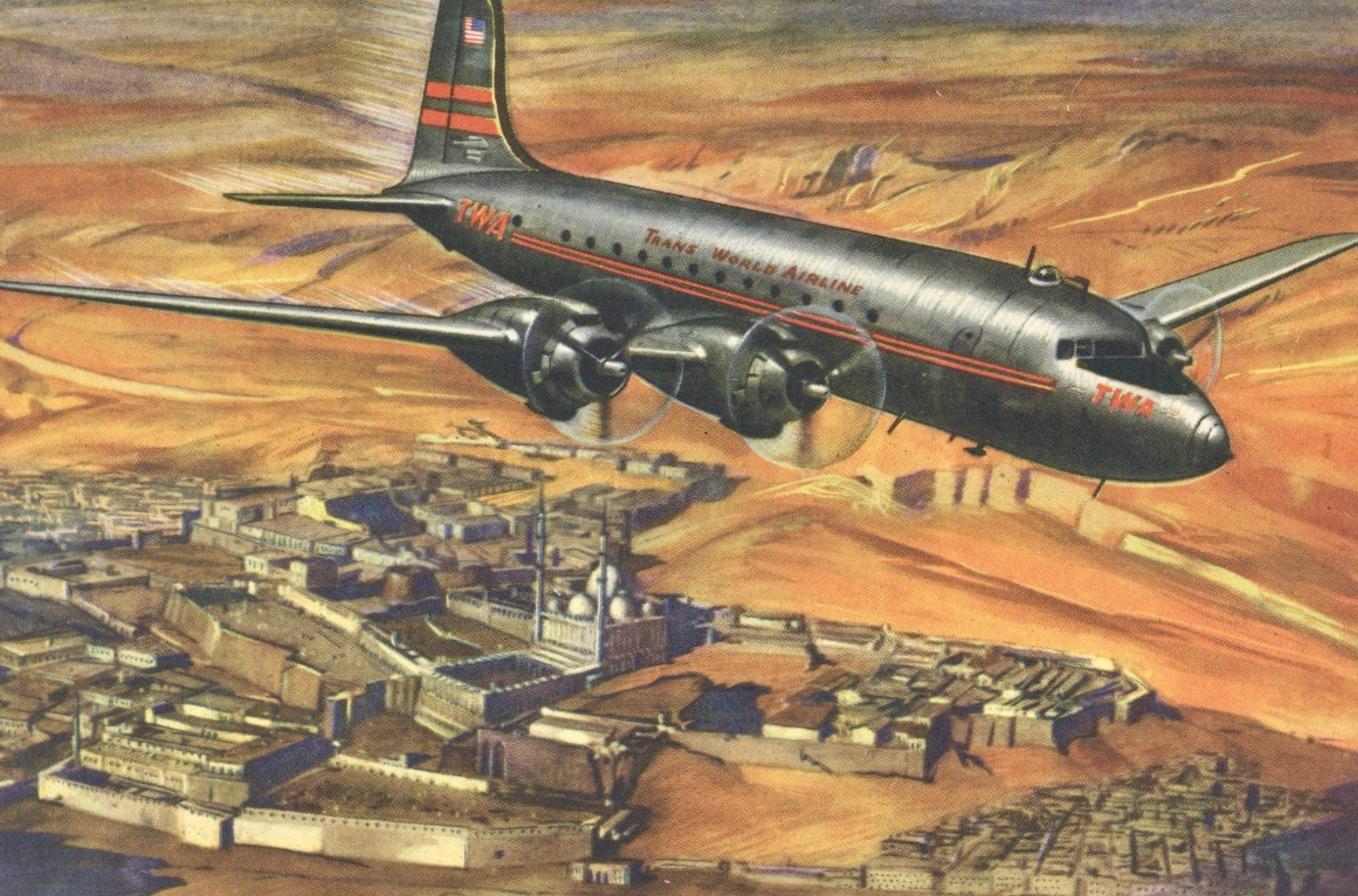
TWA Douglas DC-4 over Cairo. Airline issue, probably late 1940s or early 1950s. Pub’r Umberto Boeri Editore, Rome. Painting by the Italian artist, Manlio D’Ercoli. One of a set of at least five TWA-issued destination cards by this artist, including two other DC-4 cards (Athens and Geneva) and two Constellation cards (Shannon and Rome). The Cairo card is the least common of the set.
TWA changed its full official name to ‘Trans World Airlines’ on 17 May 1950. Meanwhile, the airline continued to sponsor and introduce newer and faster versions of the Constellation. This culminated with its introduction of the Lockheed 1649A Constellation in January 1957, considered by many as the most beautiful airliner ever built. Although this was still solely a propeller aircraft, TWA called it the ‘Jetstream Starliner’, knowing that pure jet aircraft were already in production and would soon enter service.
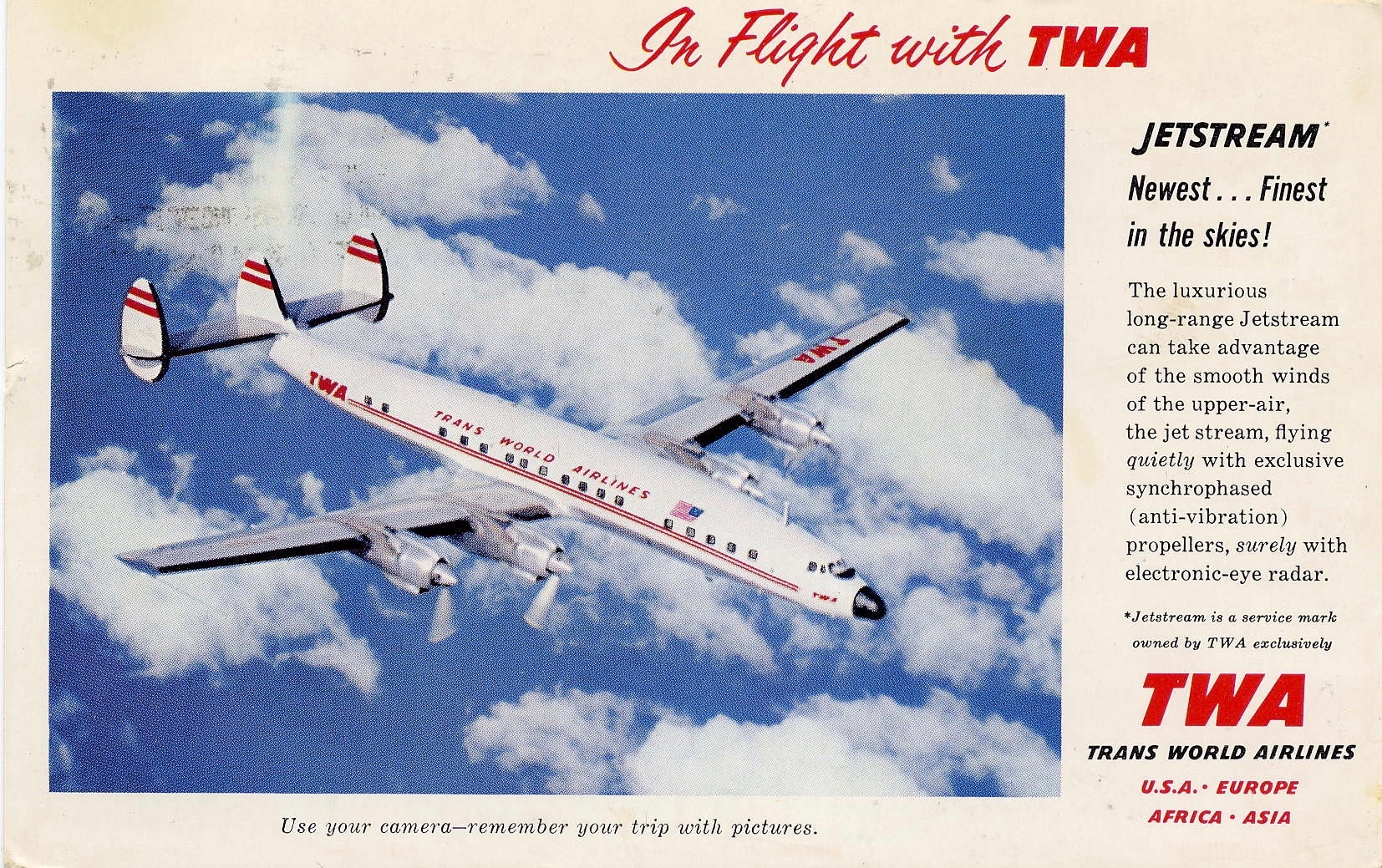
TWA Lockheed 1649A Constellation. Airline issue. I acquired this postcard from the seat pocket of this aircraft type while on a TWA flight from Rome, Italy to Bombay, India in July 1960.
For short-haul service in the 1950s, TWA introduced Martin 202s in 1950 and Martin 404s in 1951. These aircraft types served for about a decade.
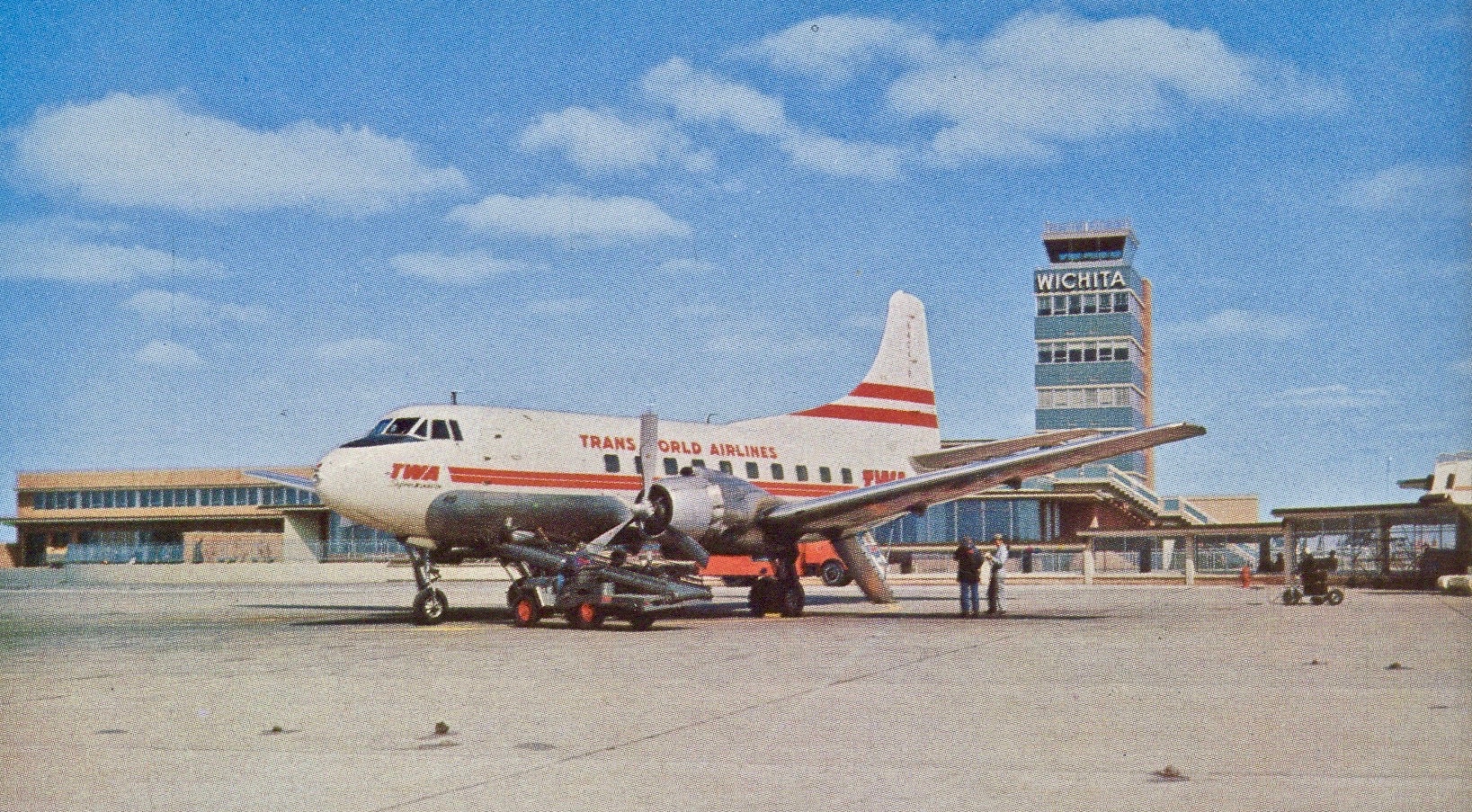
TWA Martin 404 at Wichita Municipal Airport, Kansas. Pub’r Newfer Color Card Co., Wichita, no. 83207; printed by Dexter Press. With the Martin 404, TWA introduced its ‘white top’ livery.
TWA entered the pure jet era when it received its first Boeing 707 on 17 March 1959, and the type immediately became its leading aircraft. Its 707 service was launched on 20 March 1959, on its transcontinental New York-San Francisco route. 707s served in TWA’s fleet until October 1983.
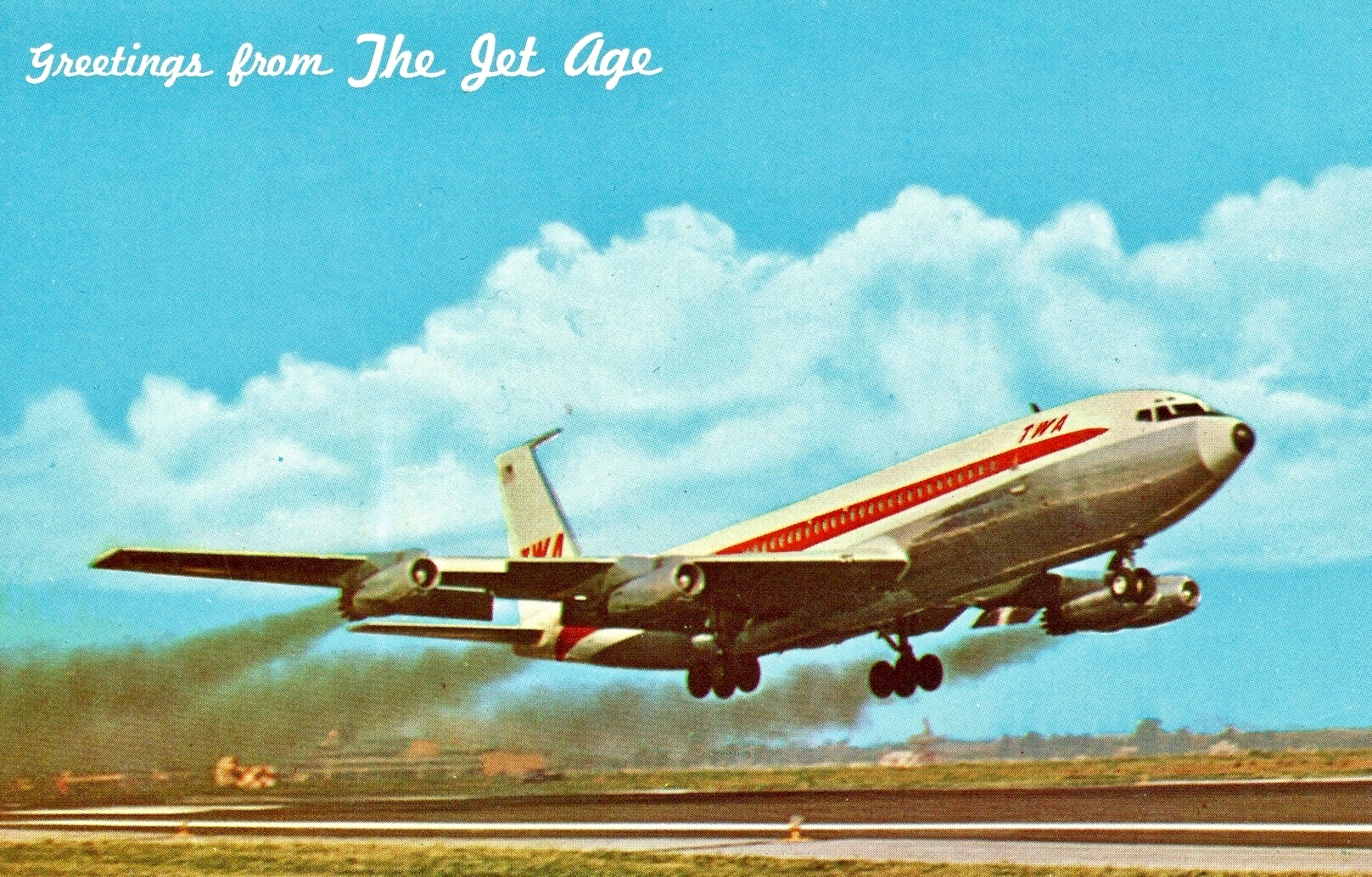
TWA Boeing 707-100. Pub’r H. S. Crocker Co., San Francisco, no. HSC-270. The earliest 707 engines spewed a lot of smoke on takeoff.
For short-haul routes in the early jet age years, TWA introduced Boeing 727s and Douglas DC-9s.
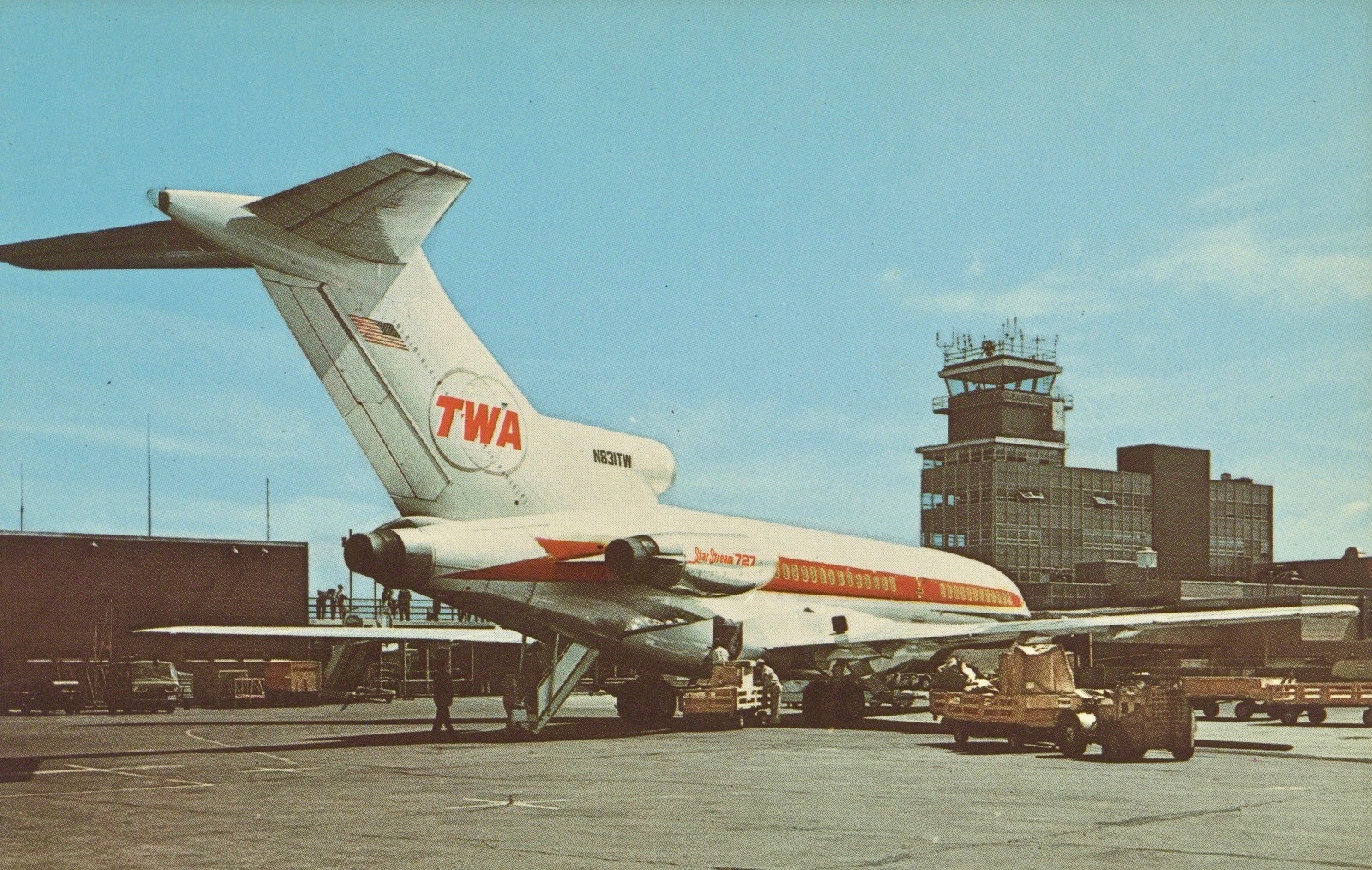
TWA Boeing 727-31H, N831TW, at Cleveland Hopkins International Airport, Ohio. Curteich no. 5DK-1973. Distributor, George R. Klein News Agency, Cleveland. Ex Allan Van Wickler collection. This aircraft was in TWA’s fleet from May 1965 to January 1992.
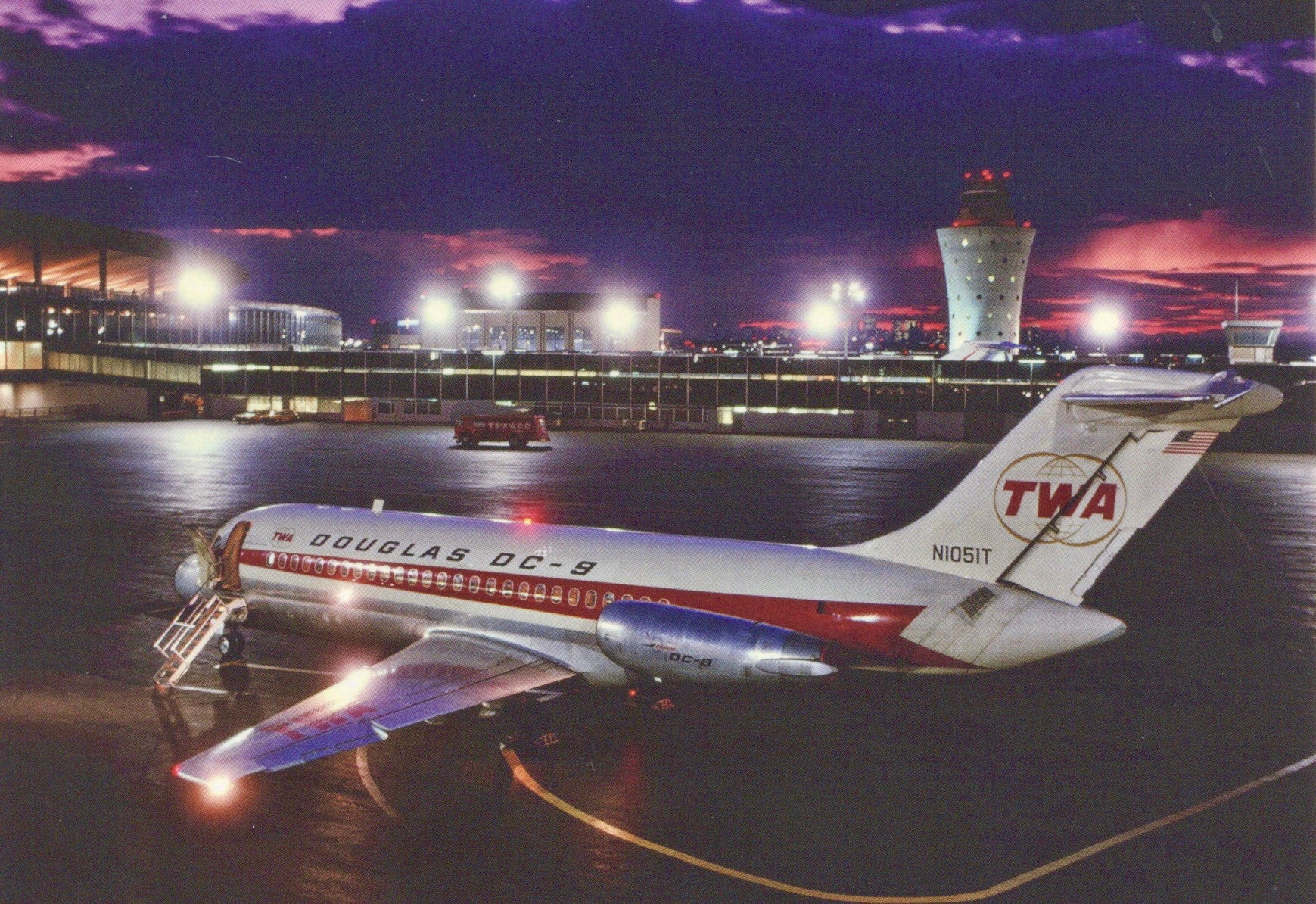
TWA Douglas DC-9-14, N1051T, its first DC-9, at New York LaGuardia Airport on a demonstration trip prior to delivery in 1965. Postcard produced by Airliners International 2010 New York, from a photo in the collection of Jon Proctor via Terry Waddington. Pub’r j.j.postcards, Bassersdorf, Switzerland.
In 1965 Boeing initiated development of the first wide body aircraft, the Boeing 747, which was twice the size of the 707. TWA ordered 12 of them in 1966, and received its first one at the end of 1969. The type, often called the ‘Jumbo Jet’ or ‘Queen of the Skies’ became the pride of TWA’s fleet, carrying its banner around the world.
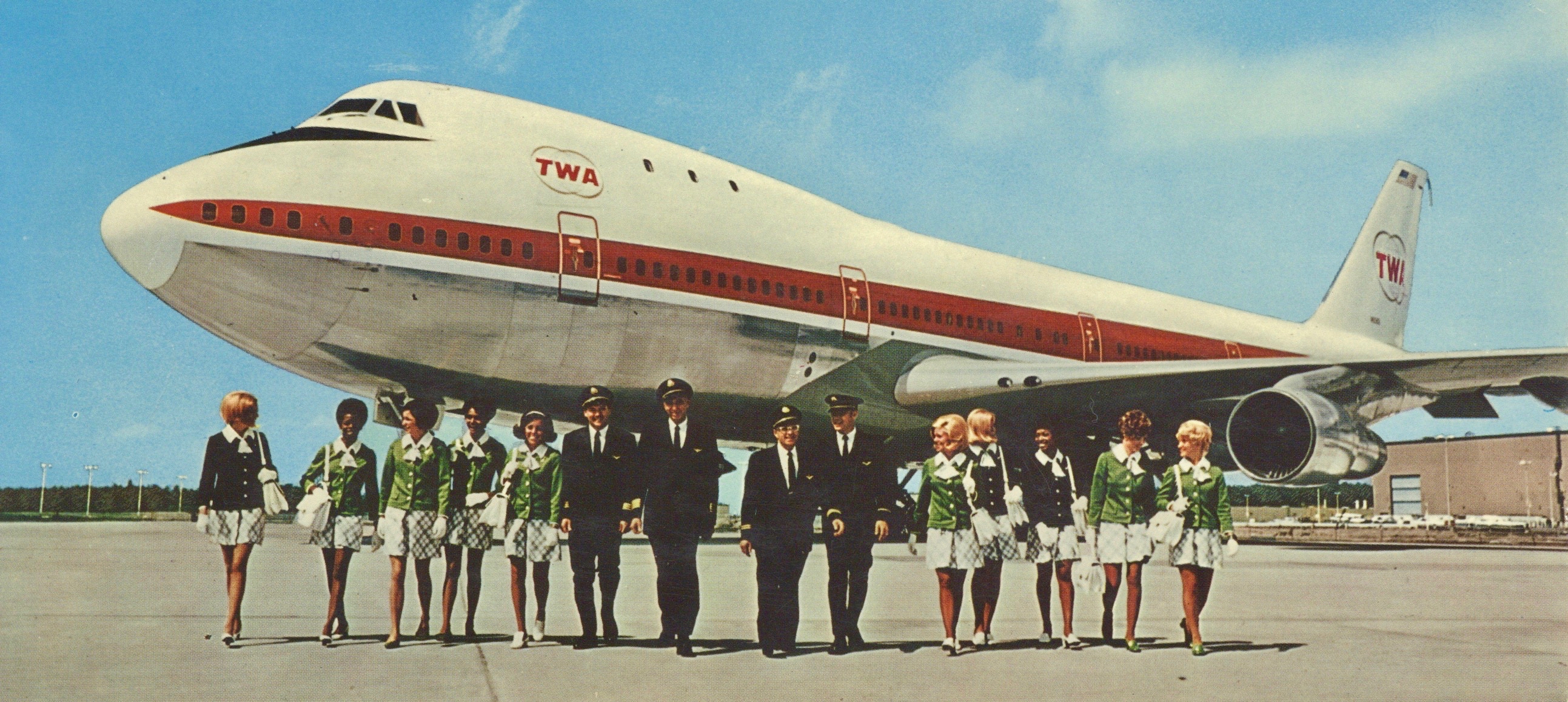
TWA 747-100 and crew. Pub’r Kruger, no. 918/54, Printer Michel & Co., Frankfurt, Germany. 4 x 8-3/4” (10 x 22 cm.)
Douglas and Lockheed entered the wide body aircraft market with tri-jets — the DC-10 and L-1011 respectively. Delta chose the L-1011, eventually operating over 40 at various times between 1972 and 1998.
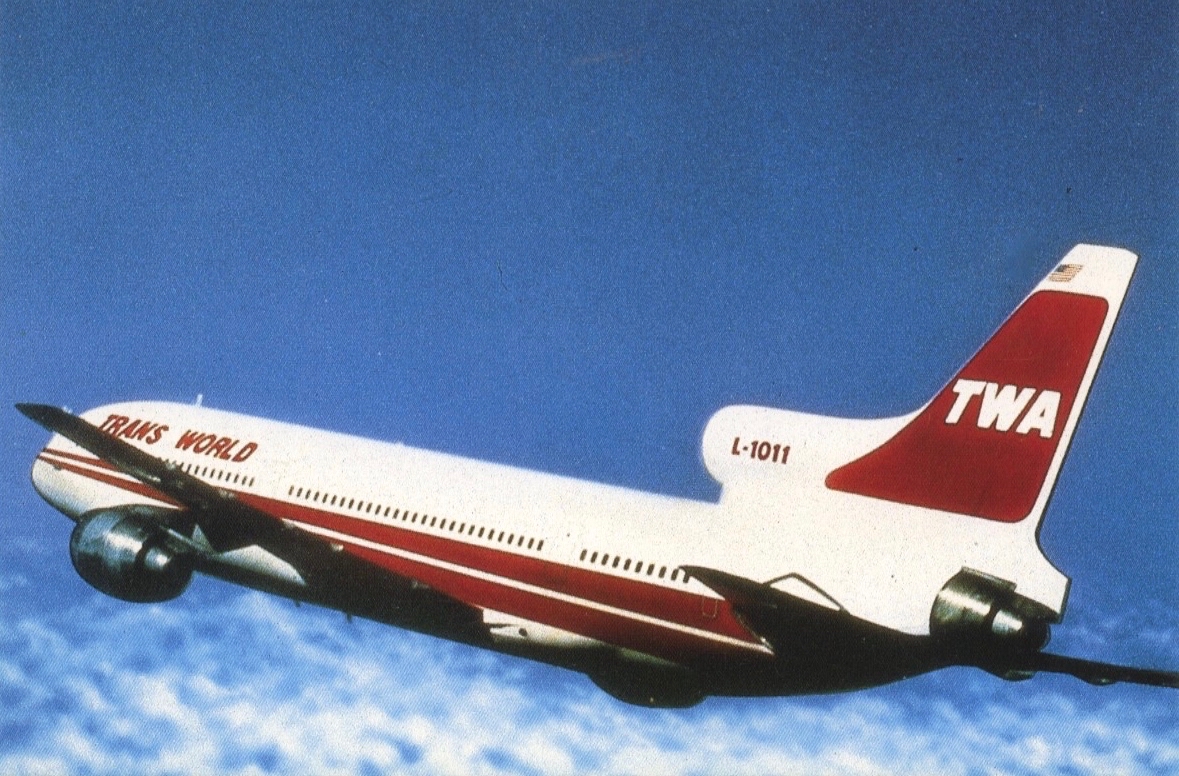
TWA Lockheed L-1011. TWA Brussels office issue. This postcard shows TWA’s revised livery introduced in 1975, but with the ‘Trans World’ titles in solid red as introduced in 1980(rather than the 1975 version of white with a red border). This dates the postcard to 1980 or later.
Boeing then developed the long-haul, wide-body 767 which featured two engines, using less fuel than the three or four-engine wide bodies. It also had a completely new flight deck design, requiring only two pilots instead of three or more and incorporating computer screens. TWA introduced this successful aircraft type on 2 December 1982. On 1 February 1985 a TWA 767 operated the first trans-Atlantic scheduled passenger service under the U.S. Federal Aviation Administration’s Extended Twin-Engine Operations (‘EROPS’, later known as ‘ETOPS’) which allowed twin-engine commercial aircraft to cross the ocean provided they operate within 120 minutes from an alternate airport (the maximum number of minutes has since been increased).
TWA paid close attention to its cargo operations and issued a few postcards advertising them. Here is my favorite:
TWA’s Douglas DC-9 fleet for short-haul service expanded with successive larger models, culminating with the DC-9-82, subsequently called the MD-82 (entered TWA service in 1983) and the MD-83 (entered TWA service in 1987). On 26 September 1986, the regional air carrier Ozark Air Lines, which also had a significant fleet of DC-9s and MD-80s, was merged into TWA.
From time to time TWA entered into arrangements with several commuter airlines that acted as feeders to its main operation. Although operated by the local airline concerned, the flight and aircraft would be branded as ‘Trans World Express’. Here is one postcard example:
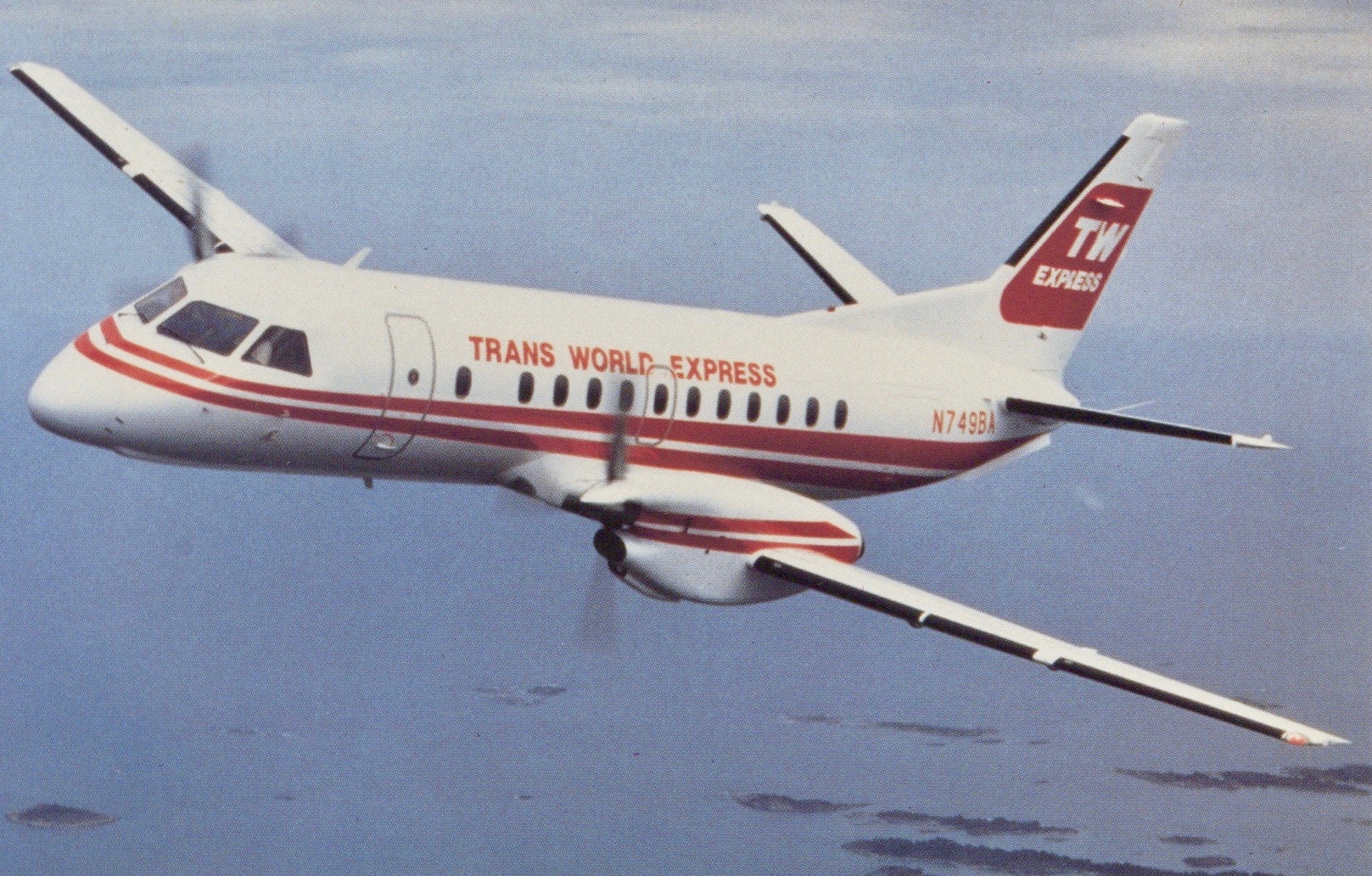
Trans World Express Saab 340B, N749BA, operated by Metro Air Northeast. Pub’r Plane Views no. 85102024.
In September 1995 TWA unveiled its final livery, featuring “Trans World’ titles and a stylized world map. Its final postcards show this livery.
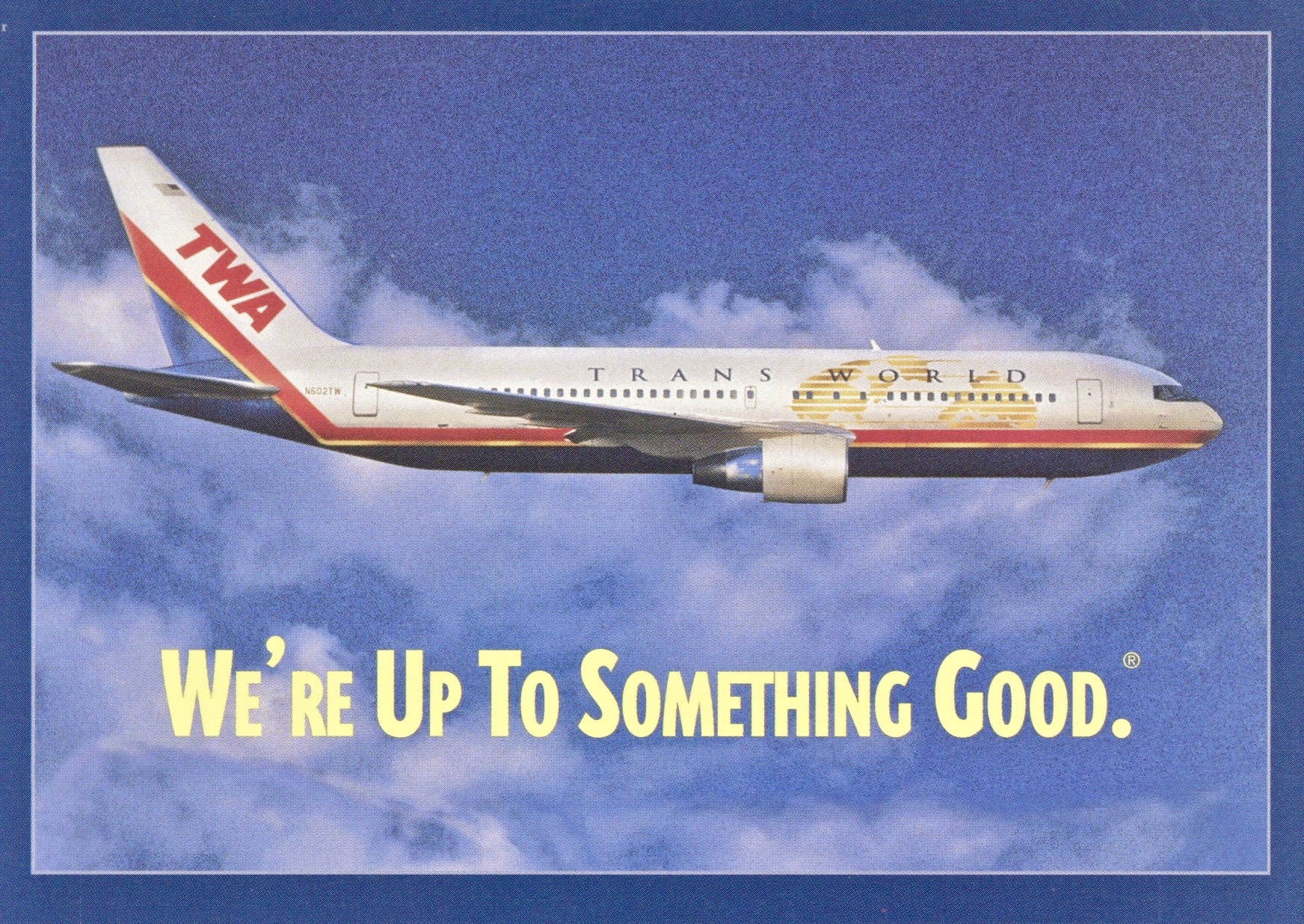
TWA Boeing 767-200, N602TW, in color scheme adopted September 1995. Airline issue no. PAS-964, April 1996.
In 1985 TWA, while battling a takeover attempt by the notorious Frank Lorenzo and his company Texas Air Corporation, found itself taken over instead by corporate raider Carl Icahn. Icahn orchestrated the merger of Ozark Air Lines into TWA in 1986, burdening TWA with excessive debt. His subsequent maneuvers further contributed to financial difficulties for the airline. TWA went through ‘chapter 11’ bankruptcy reorganization proceedings twice, in 1992 and 1995, but it never fully recovered. In 2001 American Airlines acquired TWA, ending a remarkable 75-year span for one of the world’s pioneering and most highly respected airlines.
Notes: Originals of all the postcards illustrated are in the author’s collection. My estimate of their availability: Rare: the Western Air Express F-32 at Glendale, Maddux Ford Tri-Motor with route map, TWA DC-1 interior, DC-2 in flight and DC-2 cockpit, DC-3 at Burbank, and Constellation 049; Uncommon: the TAT-Maddux Curtiss Condor at Port Columbus; TWA DC-1 at Glendale, TWA DC-3 at night; Boeing 307 in flight and interior; DC-4 over Cairo, Martin 404 at Wichita, 747 and crew, 727 at Cleveland, L-1011 Brussels issue, and TWA Cargo cards. The rest are fairly common.
References:
Davies, R. E. G., ‘TWA: An Airline and Its Aircraft’, illustrated by Mike Machat, 112 pages (Paladwr Press, 2000).
Cearley, George W., Jr., ‘TWA: A Pictorial and Illustrated History of Trans World Airlines 1925 – 1987’, 136 pages (self published, 1988).
Proctor, Jon, ‘TWA 1925 – 2001’, 64 pages (Airways Classics No. 6, 2012). The late Jon Proctor had a career with TWA spanning 28 years, including in-flight management positions. He is remembered as an outstanding airline historian and gentleman. He is the first recipient of the new annual ‘Paul Colllins’ award for excellence in serving the airline history community, awarded to him earlier in 2020 by the World Airline Historical Society.
I hope you enjoyed this article on TWA and its postcards, and until next time,
Happy Collecting,
Marvin G. Goldman
Trackback from your site.

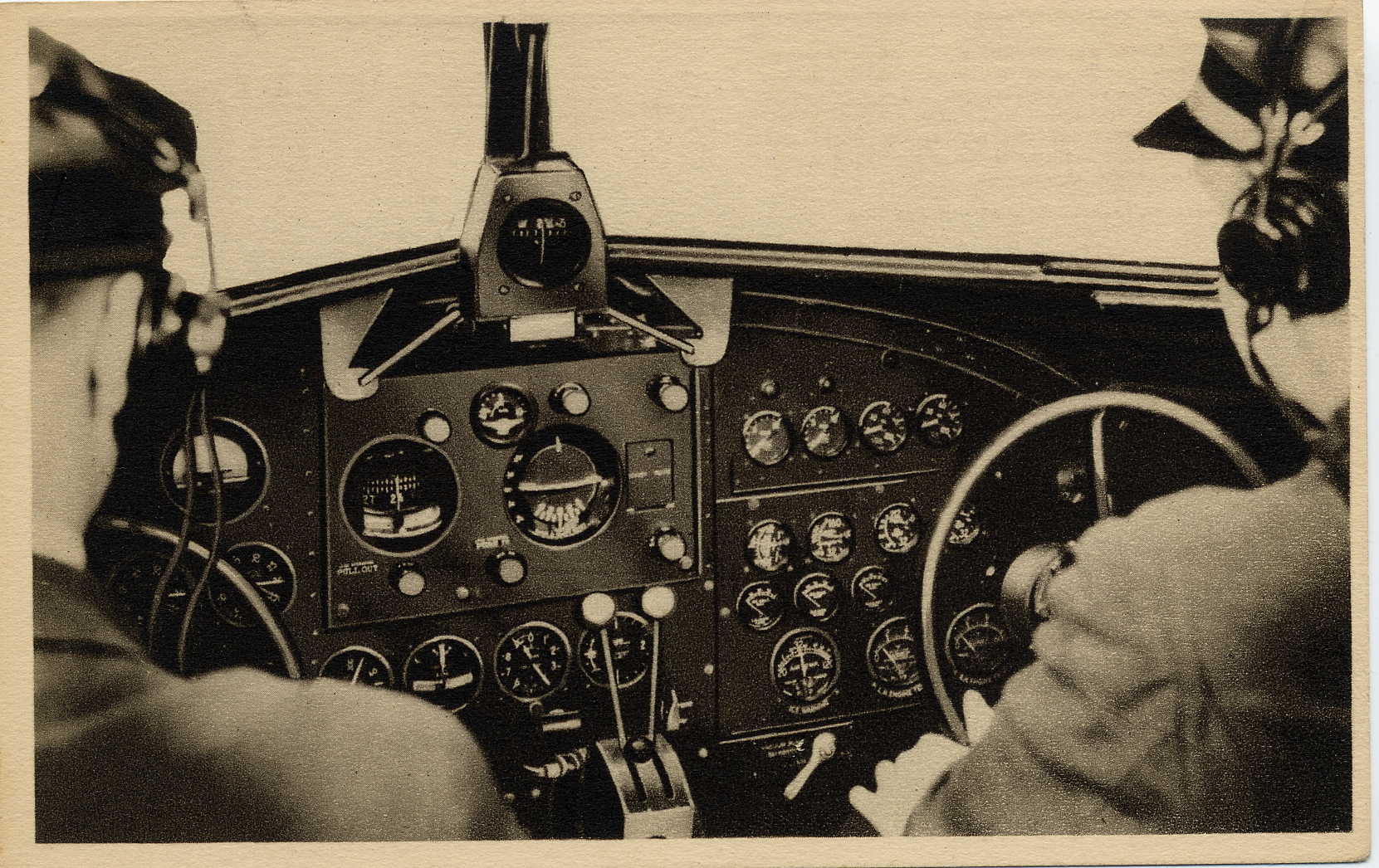
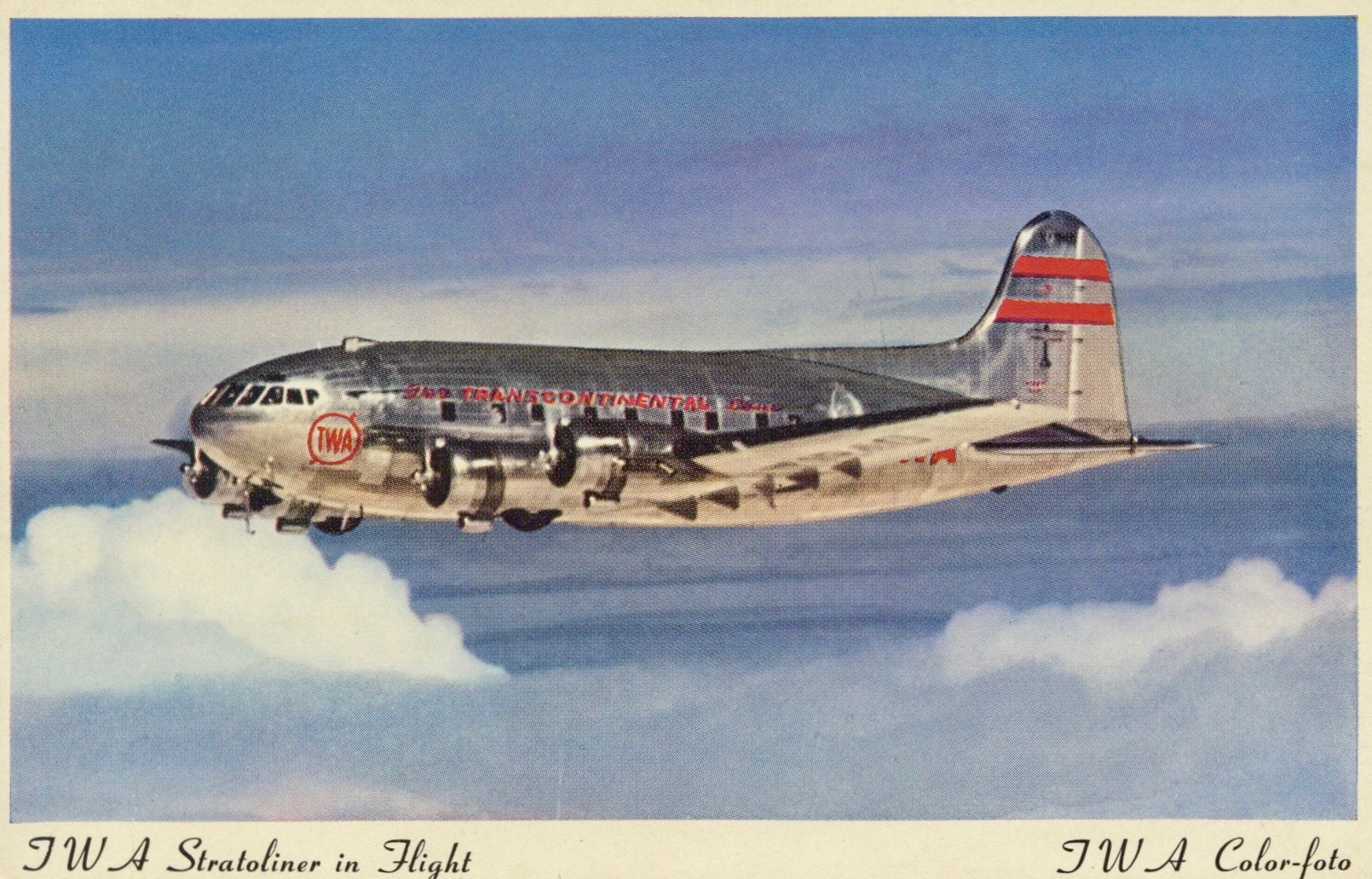
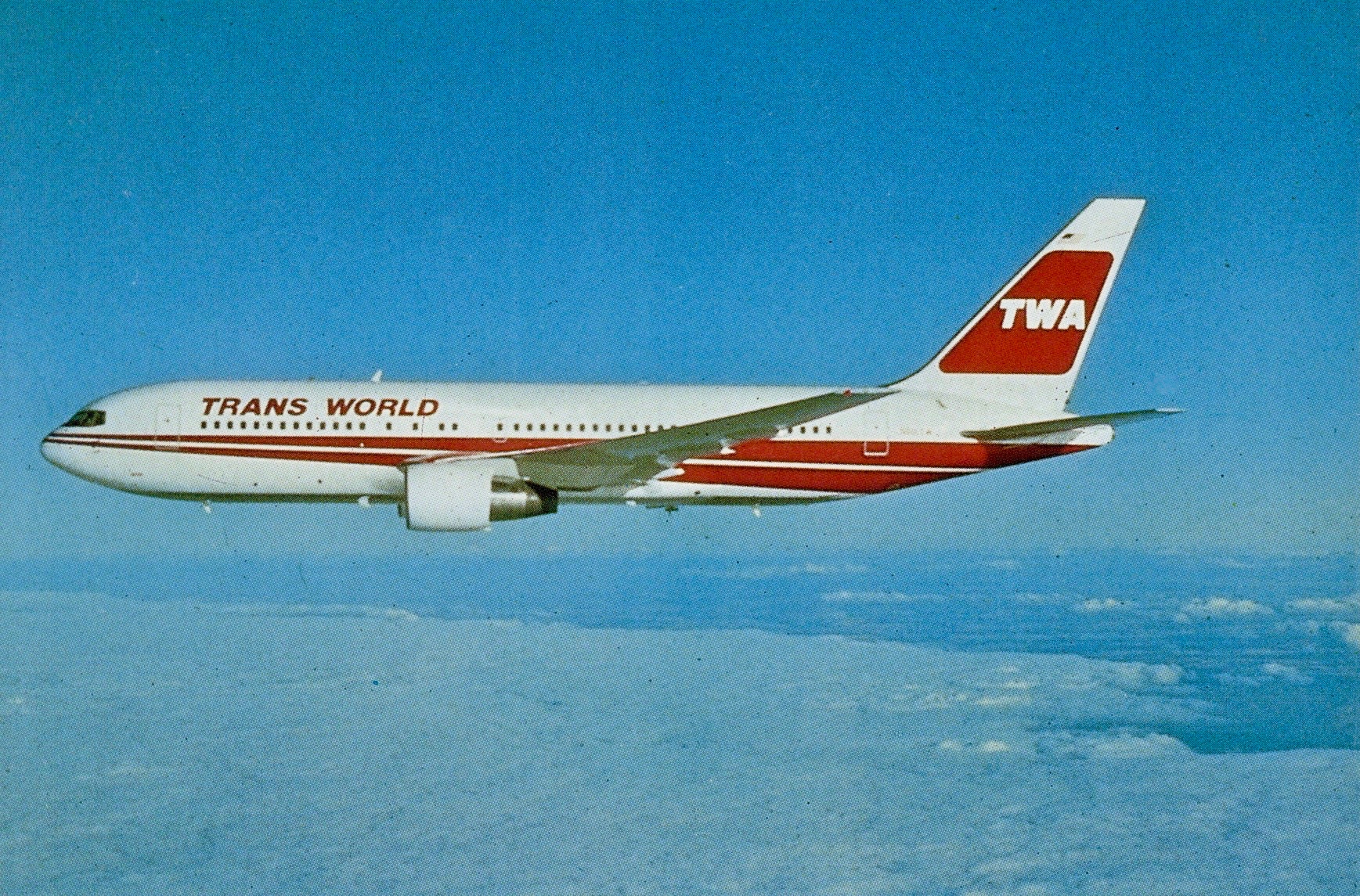

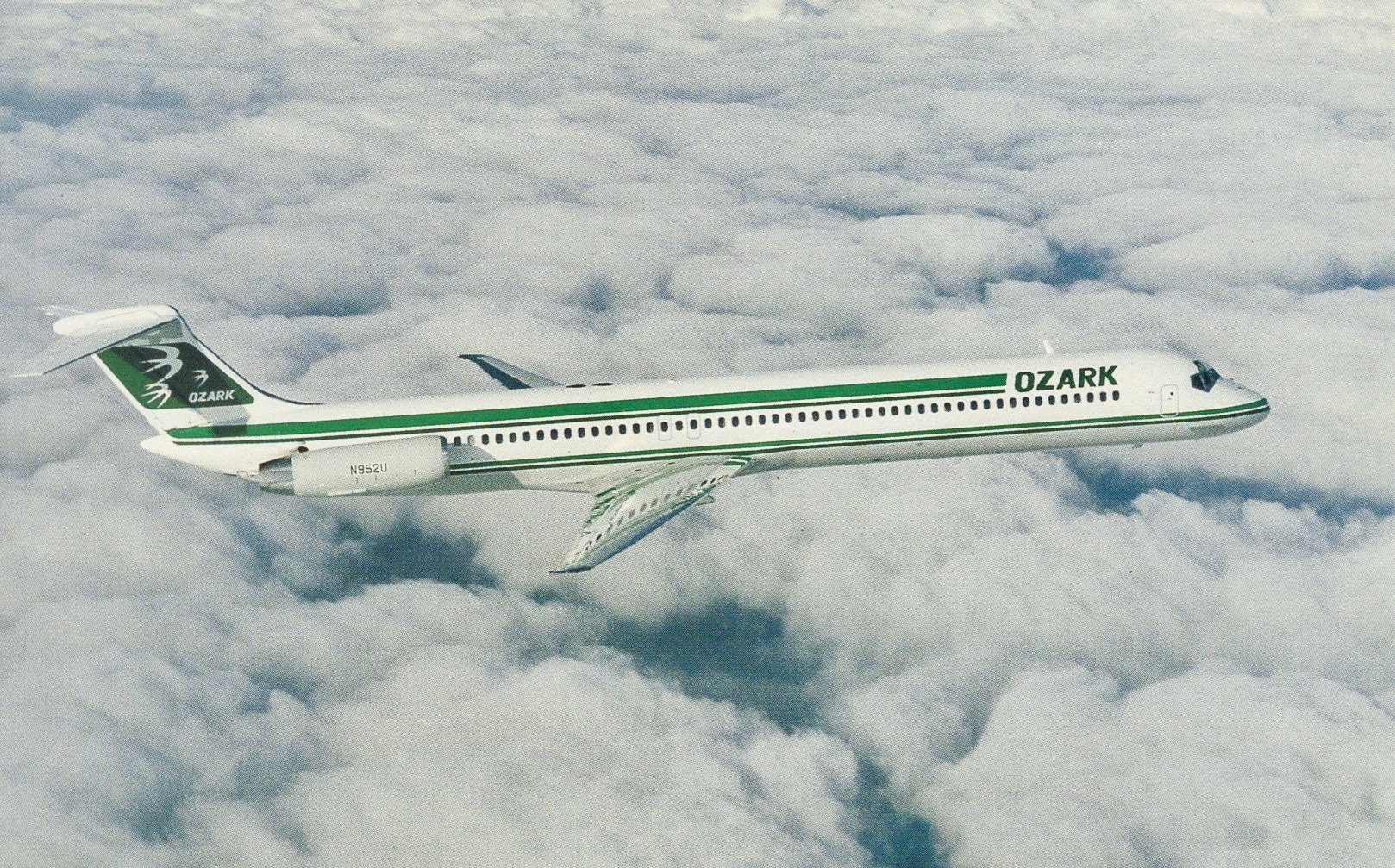
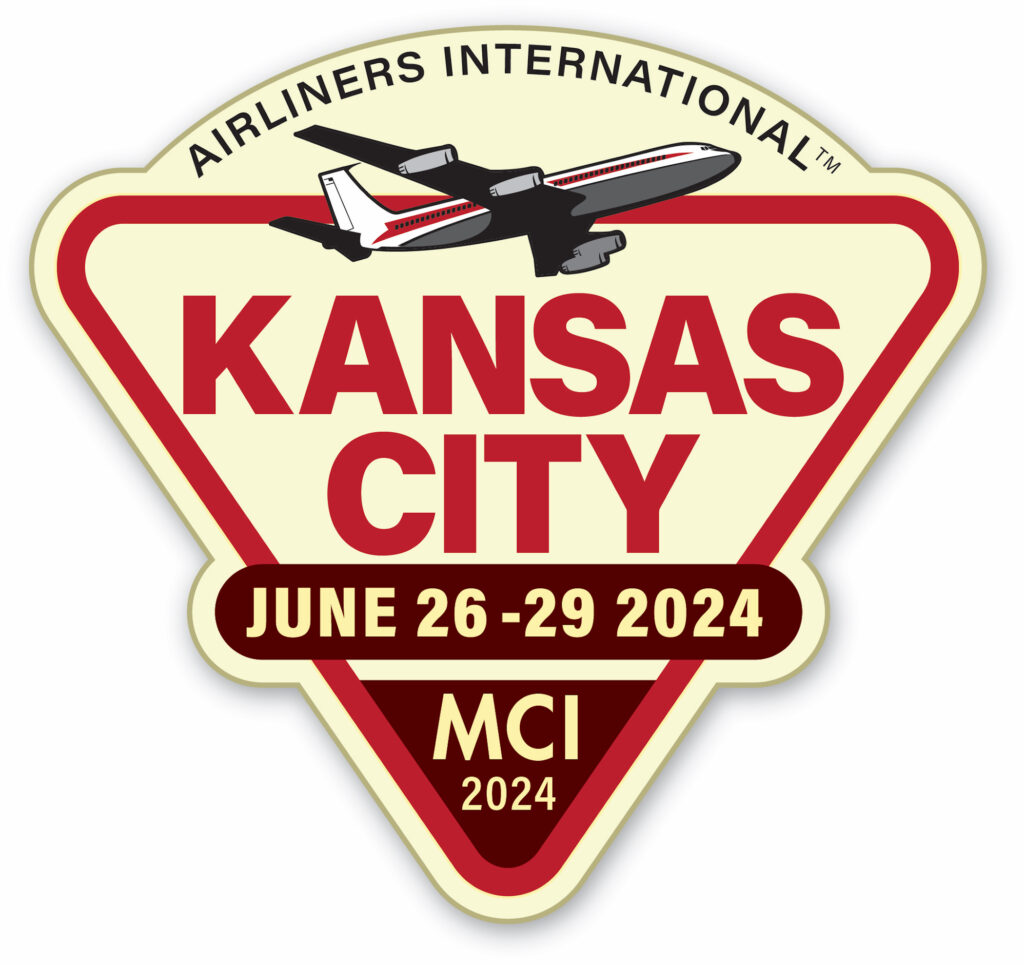
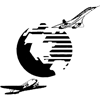
Judy Revling Hall
| #
Thank you Marvin for sharing this wonderful story and beautiful postcards of the history of TWA. As a TWA flight attendant from the late 1960s to 2001, I enjoyed the glory years of flying. I am an admirer and friend of Jon Proctor and his brother Capt. Bill Proctor. May they both RIP. Best regards, Judy Revling Hall
Reply